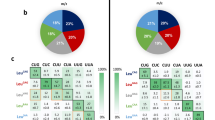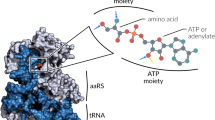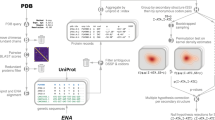Abstract
The linear sequence of amino acids contains all the necessary information for a protein to fold into its unique three-dimensional structure. Native protein sequences are known to accomplish this by promoting the formation of stable, kinetically accessible structures. Here we describe a Pro residue in the center of the third transmembrane helix of the cystic fibrosis transmembrane conductance regulator that promotes folding by a distinct mechanism: disfavoring the formation of a misfolded structure. The generality of this mechanism is supported by genome-wide transmembrane sequence analyses. Furthermore, the results provide an explanation for the increased frequency of Pro residues in transmembrane α-helices. Incorporation by nature of such 'negative folding determinants', aimed at preventing the formation of off-pathway structures, represents an additional mechanism by which folding information is encoded within the evolved sequences of proteins.
This is a preview of subscription content, access via your institution
Access options
Subscribe to this journal
Receive 12 print issues and online access
$189.00 per year
only $15.75 per issue
Buy this article
- Purchase on Springer Link
- Instant access to full article PDF
Prices may be subject to local taxes which are calculated during checkout







Similar content being viewed by others
References
Sakai, H. & Tsukihara, T. Structures of membrane proteins determined at atomic resolution. J. Biochem. 124, 1051–1059 (1998).
Jones, D.T., Taylor, W.R. & Thornton, J.M. A mutation data matrix for transmembrane proteins. FEBS Lett. 339, 269–275 (1994).
Samatey, F.A., Xu, C. & Popot, J.-L. On the distribution of amino acid residues in transmembrane α-helix bundles. Proc. Natl. Acad. Sci. USA 92, 4577–4581 (1995).
Wallin, E., Tsukihara, T., Yoshikawa, S., von Heijne, G. & Elofsson, A. Architecture of helix bundle membrane proteins: an analysis of cytochrome c oxidase from bovine mitochondria. Protein Sci. 6, 808–815 (1997).
Brandl, C.J. & Deber, C.M. Hypothesis about the function of membrane-buried proline residues in transport proteins. Proc. Natl. Acad. Sci. USA 83, 917–921 (1986).
von Heijne, G. Proline kinks in transmembrane α-helices. J. Mol. Biol. 218, 499–503 (1991).
Sansom, M.S.P. Proline residues in transmembrane helices of channel and transport proteins: a molecular modelling study. Protein Eng. 5, 53–60 (1992).
Williams, K.A. & Deber, C.M. Proline residues in transmembrane helices: structural or dynamic role? Biochemistry 30, 8919–8923 (1991).
Lu, H., Marti, T. & Booth, P.J. Proline residues in transmembrane α-helices affect the folding of bacteriorhodopsin. J. Mol. Biol. 308, 437–446 (2001).
Strader, C.D. et al. Identification of residues required for ligand binding to the β-adrenergic receptor. Proc. Natl. Acad. Sci. USA 84, 4384–4388 (1987).
Sung, C.H., Davenport, C.M. & Nathans, J. Rhodopsin mutations responsible for autosomal dominant retinitis pigmentosa. Clustering of functional classes along the polypeptide chain. J. Biol. Chem. 268, 26645–26649 (1993).
Wellner, M., Monden, I., Mueckler, M.M. & Keller, K. Functional consequences of proline mutations in the putative transmembrane segments 6 and 10 of the glucose transporter GLUT1. Eur. J. Biochem. 227, 454–458 (1995).
Sheppard, D.N., Travis, S.M., Ishihara, H. & Welsh, M.J. Contribution of proline residues in the membrane-spanning domains of cystic fibrosis transmembrane conductance regulator to chloride channel function. J. Biol. Chem. 271, 14995–15001 (1996).
Hong, S., Ryu, K.S., Oh, M.S., Ji, I. & Ji, T.H. Roles of transmembrane prolines and proline-induced kinks of the lutropin/choriogonadotropin receptor. J. Biol. Chem. 272, 4166–4171 (1997).
Thomas, P.J., Qu, B.-H. & Pedersen, P.L. Defective protein folding as a basis of human disease. TIBS 20, 456–459 (1995).
Riordan, J.R. et al. Identification of the cystic fibrosis gene: cloning and characterization of complementary DNA. Science 245, 1066–1073 (1989).
Wigley, W.C. et al. Dynamic association of proteasomal machinery with the centrosome. J. Cell Biol. 145, 481–490 (1999).
Popot, J.L. & Engelman, D.M. Membrane protein folding and oligomerization: the two-stage model. Biochemistry 29, 4031–4037 (1990).
Lemmon, M.A. & Engelman, D.M. Specificity and promiscuity in membrane helix interactions. Q. Rev. Biophys. 27, 157–218 (1994).
White, S.H. & Wimley, W.C. Membrane protein folding and stability: physical principles. Annu. Rev. Biophys. Biomol. Struct. 28, 319–365 (1999).
Gierasch, L.M., Lacy, J.E., Thompson, K.F., Rockwell, A.L. & Watnick, P.I. Conformations of model peptides in membrane-mimetic environments. Biophys. J. 37, 275–284 (1982).
Chen, Y.H., Yang, J.T. & Chau, K.H. Determination of the helix and β form of proteins in aqueous solution by circular dichroism. Biochemistry 13, 3350–3359 (1974).
Yang, J.T., Wu, C.S. & Martinez, H.M. Calculation of protein conformation from circular dichroism. Methods Enzymol. 130, 208–269 (1986).
Bohm, G., Muhr, R. & Jaenicke, R. Quantitative analysis of protein far UV circular dichroism spectra by neural networks. Protein Eng. 5, 191–195 (1992).
Jasanoff, A. & Fersht, A.R. Quantitative determination of helical propensities from trifluoroethanol titration curves. Biochemistry 33, 2129–2135 (1994).
Mothes, W. et al. Molecular mechanism of membrane protein integration into the endoplasmic reticulum. Cell 89, 523–533 (1997).
Hamman, B.D., Chen, J.C., Johnson, E.E. & Johnson, A.E. The aqueous pore through the translocon has a diameter of 40–60 Å during cotranslational protein translocation at the ER membrane. Cell 89, 535–544 (1997).
Zerial, M., Huylebroeck, D. & Garoff, H. Foreign transmembrane peptides replacing the internal signal sequence of transferrin receptor allow its translocation and membrane binding. Cell 48, 147–155 (1987).
Chang, X.B., Hou, Y.X., Jensen, T.J. & Riordan, J.R. Mapping of cystic fibrosis transmembrane conductance regulator membrane topology by glycosylation site insertion. J. Biol. Chem. 269, 18572–18575 (1994).
Wigley, W.C., Vijayakumar, S., Jones, J.D., Slaughter, C. & Thomas, P.J. The transmembrane domain of CFTR: design, characterization and secondary structure of synthetic peptides m1–m6. Biochemistry 37, 844–853 (1998).
Dong, A., Huang, P. & Caughey, W.S. Protein secondary structures in water from second-derivative amide I infrared spectra. Biochemistry 29, 3303–3308 (1990).
Dobson, C.M. Protein misfolding, evolution and disease. TIBS 24, 329–332 (1999).
LeVine, H. III . Thioflavin T interaction with synthetic Alzheimer's disease β-amyloid peptides: detection of amyloid aggregation in solution. Protein Sci. 2, 404–410 (1993).
Richardson, J.S. & Richardson, D.C. Prediction of protein structure and the principles of protein conformation. (ed. Fasman, G.D.) 1–98 (Plenum, New York; 1989).
Mitraki, A., Fane, B., Haase-Pettingell, C., Sturtevant, J. & King, J. Global suppression of protein folding defects and inclusion body formation. Science 253, 54–58 (1991).
Zhou, Y. & Karplus, M. Folding of a model three-helix bundle protein: a thermodynamic and kinetic analysis. J. Mol. Biol. 293, 917–951 (1999).
Hill, R.B. & DeGrado, W.F. A polar, solvent-exposed residue can be essential for native protein structure. Structure. Fold. Des. 8, 471–479 (2000).
Wood, S.J., Wetzel, R., Martin, J.D. & Hurle, M.R. Prolines and amyloidogenicity in fragments of the Alzheimer's peptide β/A4. Biochemistry 34, 724–730 (1995).
Moriarty, D.F. & Raleigh, D.P. Effects of sequential proline substitutions on amyloid formation by human amylin 20–29. Biochemistry 38, 1811–1818 (1999).
Chou, P.Y. & Fasman, G.D. Empirical predictions of protein conformation. Annu. Rev. Biochem. 47, 251–276 (1978).
Rost, B., Fariselli, P. & Casadio, R. Topology prediction for helical transmembrane proteins at 86% accuracy. Protein Sci. 5, 1704–1718 (1996).
Li, S.-C. & Deber, C.M. A measure of helical propensity for amino acids in membrane environments. Nature Struct. Biol. 1, 368–373 (1994).
Anfinsen, C.B. Principles that govern the folding of protein chains. Science 181, 223–230 (1973).
Fandrich, M., Fletcher, M.A. & Dobson, C.M. Amyloid fibrils from muscle myoglobin. Nature 410, 165–166 (2001).
Pertinhez, T.A. et al. Amyloid fibril formation by a helical cytochrome. FEBS Lett. 495, 184–186 (2001).
Crowther, R.A. & Goedert, M. Abnormal tau-containing filaments in neurodegenerative diseases. J. Struct. Biol. 130, 271–279 (2000).
Betsholtz, C. et al. Sequence divergence in a specific region of islet amyloid polypeptide (IAPP) explains differences in islet amyloid formation between species. FEBS Lett. 251, 261–264 (1989).
Bradford, M.M. A rapid and sensitive method for the quantitation of microgram quantities of protein utilizing the principle of protein-dye binding. Anal. Biochem. 72, 248–254 (1976).
Acknowledgements
We thank members of the Thomas and Rizo laboratories for valuable discussions, S. Madden and B. Riek for expert technical assistance, B. Rost for prediction of TM α-helices, and L. Gierasch, D. Hilgemann, E. Ross, B. Goldsmith, R. Ranganathan, S. Muallem and S. Sprang for helpful comments. This work was supported by research grants from the Cystic Fibrosis Foundation and the National Institutes of Health-NIDDK to P.J.T. P.H.T is supported by an NIH predoctoral training grant. M.J.C. is the recipient of a CF Foundation fellowship. P.J.T. is an Established Investigator of the American Heart Association.
Author information
Authors and Affiliations
Corresponding author
Ethics declarations
Competing interests
The authors declare no competing financial interests.
Rights and permissions
About this article
Cite this article
Wigley, W., Corboy, M., Cutler, T. et al. A protein sequence that can encode native structure by disfavoring alternate conformations. Nat Struct Mol Biol 9, 381–388 (2002). https://doi.org/10.1038/nsb784
Received:
Accepted:
Published:
Issue Date:
DOI: https://doi.org/10.1038/nsb784
This article is cited by
-
Membranes as the third genetic code
Molecular Biology Reports (2020)



